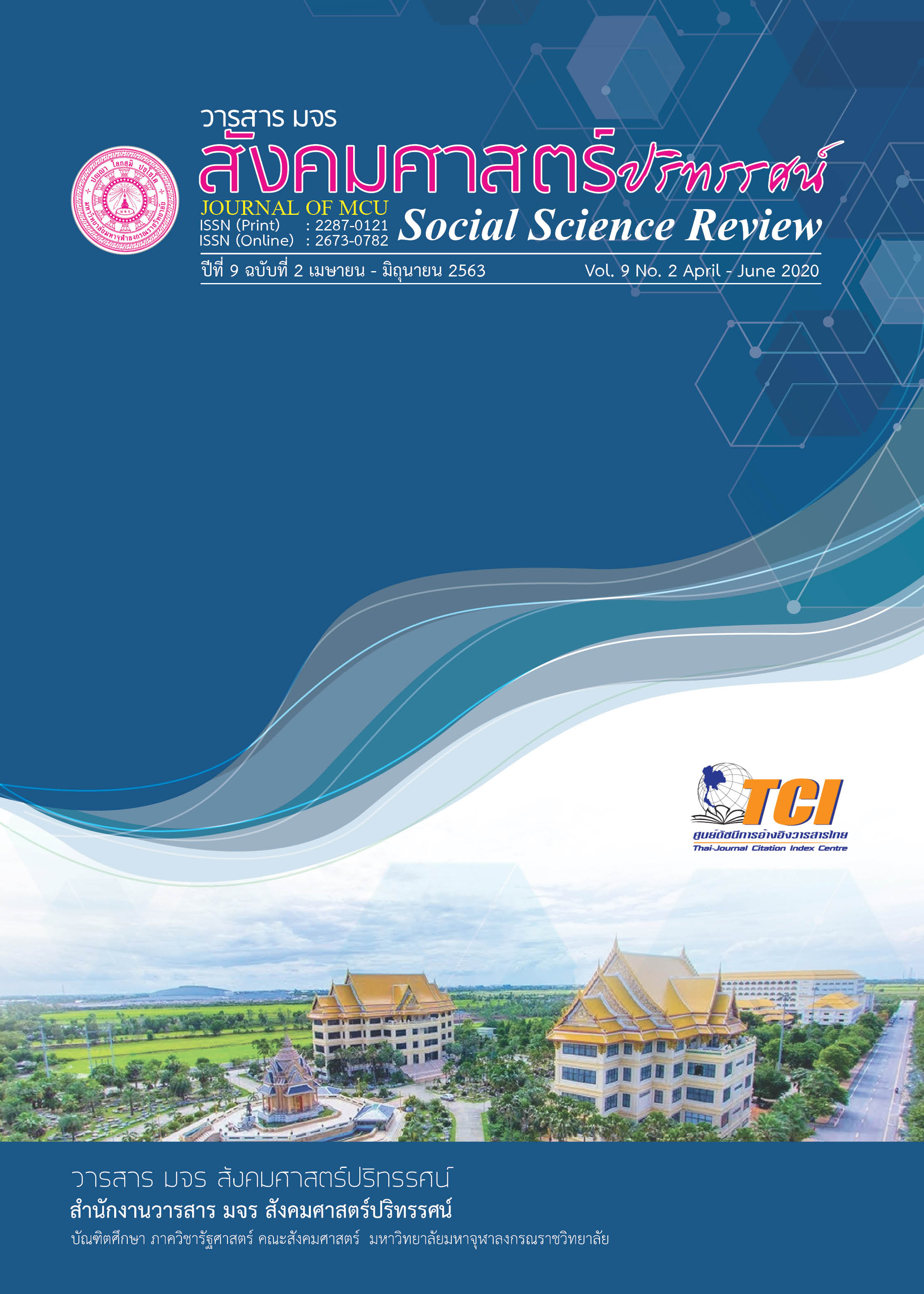รูปแบบการพัฒนาการเทศนาของพระสงฆ์จังหวัดสมุทรปราการ
คำสำคัญ:
รูปแบบ, การเทศนา, พระสงฆ์บทคัดย่อ
บทความวิจัยฉบับนี้มีวัตถุประสงค์เพื่อศึกษาสภาพทั่วไป ปัจจัยเพื่อการพัฒนาและนำเสนอรูปแบบการพัฒนาการเทศนาของพระสงฆ์จังหวัดสมุทรปราการ เป็นการวิจัยแบบผสานวิธี สัมภาษณ์ผู้ให้ข้อมูลสำคัญ 25 รูป/คน วิเคราะห์ข้อมูลด้วยการพรรณนาความ และการวิจัยเชิงปริมาณ เก็บข้อมูลด้วยแบบสอบถามจากกลุ่มตัวอย่าง 363 รูป สถิติที่ใช้ คือ ความถี่ ร้อยละ ค่าเฉลี่ย ส่วนเบี่ยงเบนมาตรฐาน ผลการวิจัยพบว่า 1.สภาพทั่วไปในการเทศนาของพระสงฆ์ พบว่า พระนักเทศนา ส่วนใหญ่อายุมาก ขาดการพัฒนาการเทศนาเนื้อหาสาระในการเทศนาส่วนใหญ่นำนิทานชาดก มาประกอบการเทศนา 2. ปัจจัยในการพัฒนาการเทศนาของพระสงฆ์จังหวัดสมุทรปราการโดยรวมอยู่ในระดับมาก (=4.14) เมื่อพิจารณาด้าน ได้แก่ ช่องทางการสื่อสาร (Channel) พัฒนาตามหลักอายตนะ (
=4.30) ผู้ส่งสาร (Sender) พัฒนาตามหลักพุทธวิธี 4 ส. (
=4.17) ข้อมูลข่าวสาร (Message) พัฒนาตามหลักวจีสุจริต (
=4.07) ผู้รับสาร (Receiver) พัฒนาตามหลักวุฒิธรรม (
=4.03) ตามลำดับ 3. รูปแบบการพัฒนาการเทศนาของพระสงฆ์จังหวัดสมุทรปราการ คือ 1) ด้านผู้ส่งสาร (Sender) คือ พระนักเทศนาต้องเข้าใจหลักธรรมที่นำมาเทศนา เพื่อชี้แจงให้เห็นชัดในธรรมที่แสดง ว่าสามารถนำไปประพฤติปฏิบัติใช้ในการดำเนินชีวิตได้จริง 2) ด้านสาร (Message) คือ เนื้อหาการเทศนา เสนอแนะให้คำแนะนำแก่คนฟังและเพื่อปฏิบัติต่อกันในสังคม หลักธรรมที่นำมาเทศนา ต้องเป็นประโยชน์แก่คนฟัง 3) ด้านช่องทางในการส่ง (Channel) คือ พระนักเทศนา มีคำเทศนาเสนาะหูคนฟัง มีจังหวะการเทศนาที่น่าติดตาม เสียงเทศนาต้องดังพอและฟังชัด บุคลิกน่าเลื่อมใสศรัทธา 4) ด้านผู้รับ (Receiver) คือ พระเทศนาจะต้องออกแบบหลักสูตรให้ชัดเจนเหมาะกับความต้องการและความสนใจของหน่วยงานและองค์กรนั้นๆ ที่ไปเทศนา
เอกสารอ้างอิง
กรกต ชาบัณฑิต. (2562). การกำหนดยุทธศาสตร์การเผยแผ่พระพุทธศาสนาของพระธรรมทูตไทยสู่ประชาคมอาเซียน. วารสาร มจร สังคมศาสตร์ปริทรรศน์, 8(1), 238-252.
เกียรติศักดิ์ สุขเหลือง. (2561). กลยุทธ์การบริหารองค์กรสงฆ์ที่เข้มแข็งในยุคโลกาภิวัฒน์. วารสาร มจร สังคมศาสตร์ปริทรรศน์, 7(1) 99-115.
ชญาชล คลังกรณ์. (2559). ศึกษาวิเคราะห์หลักสัมมาวาจาเพื่อการประนีประนอม : กรณีศึกษาผู้ประนีประนอมประจำศาลจังหวัดอุตรดิตถ์. วารสารสันติศึกษาปริทรรศน์ มจร, 4(ฉบับพิเศษ), 221.
พระครูพิศิษฎ์ประชานาถ (ประยูร นนฺทิโย) และคณะ. (2563). การพัฒนาการมีส่วนร่วมของพระสงฆ์ ในการพัฒนาชุมชนตามแนววิถีพุทธในจังหวัดสมุทรสงคราม (วิทยานิพนธ์ปริญญาพุทธศาสตรดุษฎีบัณฑิต สาขาวิชาการจัดการเชิงพุทธ). พระนครศรีอยุธยา: มหาวิทยาลัยมหาจุฬาลงกรณราชวิทยาลัย.
พระครูวิจิตรธรรมวิภัช ปญฺญาวุโธ. (2562). การพัฒนาการส่งเสริมการปฏิบัติธรรมของสำนักปฏิบัติธรรม ประจำจังหวัดประจวบคีรีขันธ์ (วิทยานิพนธ์ปริญญาพุทธศาสตรดุษฎีบัณฑิต สาขาวิชาการจัดการเชิงพุทธ). พระนครศรีอยุธยา: มหาวิทยาลัยมหาจุฬาลงกรณราชวิทยาลัย.
พระครูวิสุทธิสีลาภิวัฒน์ (เมธาภิวัฒน์ ฐิติโก) และคณะ. (2563). การขับเคลื่อนแผนยุทธศาสตร์การปฏิรูปกิจการพระพุทธศาสนาด้านการปกครองของคณะสงฆ์จังหวัดสระบุรี (วิทยานิพนธ์ปริญญาพุทธศาสตรดุษฎีบัณฑิต สาขาวิชาการจัดการเชิงพุทธ). พระนครศรีอยุธยา: มหาวิทยาลัยมหาจุฬาลงกรณราชวิทยาลัย.
พระครูสังฆรักษ์ปัญญาพล ปญฺญาพโลและคณะ. (2562). กลไกการพัฒนาศักยภาพในการปฏิบัติงานของพระวินยาธิการ จังหวัดพระนครศรีอยุธยา (วิทยานิพนธ์ปริญญาพุทธศาสตรดุษฎีบัณฑิต สาขาวิชาการจัดการเชิงพุทธ). พระนครศรีอยุธยา: มหาวิทยาลัยมหาจุฬาลงกรณราชวิทยาลัย.
พระครูสิริสุตาภิมณฑ์. (2559). แนวทางการเผยแผ่พระพุทธศาสนาของพระภิกษุและสามเณรชนเผ่าในเขตการปกครอง คณะสงฆ์ภาค 7. วารสารวิชาการ. มหาวิทยาลัยธนบุรี, 10(22), 47-59.
พระครูสุกิจจานุรักษ์ ชยุตม์ ดอกกุหลาบ. (2562). การส่งเสริมการใช้เทคโนโลยีสารสนเทศเพื่อการเผยแผ่พระพุทธศาสนาของพระสงฆ์ในจังหวัดสุพรรณบุรี (วิทยานิพนธ์ปริญญาพุทธศาสตรดุษฎีบัณฑิต สาขาวิชาการจัดการเชิงพุทธ). พระนครศรีอยุธยา: มหาวิทยาลัยมหาจุฬาลงกรณราชวิทยาลัย.
พระครูอาทรวชิรกิจ (มานะ ฐานิสฺสโร) และคณะ. (2563). การจัดการหน่วยอบรมประชาชนประจำตำบลในจังหวัดกำแพงเพชร (วิทยานิพนธ์ปริญญาพุทธศาสตรดุษฎีบัณฑิต สาขาวิชาการจัดการเชิงพุทธ). พระนครศรีอยุธยา: มหาวิทยาลัยมหาจุฬาลงกรณราชวิทยาลัย.
พระเฉลิมพล อชิโต. (2562). ภาวะผู้นำในการปกครองคณะสงฆ์ของพระสังฆาธิการ อำเภอ บางบาลจังหวัด พระนครศรีอยุธยา. วารสาร มจร สังคมศาสตร์ปริทรรศน์, 8(1), 84-95.
พระเทพสิงหวราจารย์ โสภณ โสภโณ. (2562). การพัฒนากลไกการขับเคลื่อนโครงการหมู่บ้านรักษาศีล 5 ของคณะสงฆ์จังหวัดเชียงใหม่ (วิทยานิพนธ์ปริญญาพุทธศาสตรดุษฎีบัณฑิต สาขาวิชาการจัดการเชิงพุทธ). พระนครศรีอยุธยา: มหาวิทยาลัยมหาจุฬาลงกรณราชวิทยาลัย.
พระมหามฆวินทร์ ปุริสุตฺตโม และคณะ. (2560). วิเคราะห์คุณธรรมและคุณค่าที่ปรากฏในการเทศนามหาชาติ. วารสารบัณฑิตศึกษาปริทรรศน์, 13(1), 124.
พระมหาสมชาย กลิ่นชาญ. (2559). การเผยแผ่พระพุทธศาสนา : การพัฒนารูปแบบและวิธีการเชิงรุกของคณะสงฆ์ไทย. วารสาร มจร สังคมศาสตร์ปริทรรศน์, 5(1), 206-207.
พระสมุห์สมชาย สิริสมฺปนฺโน. (2563). การปลูกฝังเยาวชนให้มีศรัทธาต่อพระพุทธศาสนา ของคณะสงฆ์จังหวัดสระบุรี. วารสารสันติศึกษาปริทรรศน์ มจร, 8(1), 211-221.
สำนักงานพระพุทธศาสนาแห่งชาติ. (2540). คู่มือการปฏิบัติงาน. กรุงเทพฯ: กองพุทธศาสนศึกษา.
ดาวน์โหลด
เผยแพร่แล้ว
รูปแบบการอ้างอิง
ฉบับ
ประเภทบทความ
สัญญาอนุญาต
ลิขสิทธิ์ (c) 2020 วารสาร มจร สังคมศาสตร์ปริทรรศน์

อนุญาตภายใต้เงื่อนไข Creative Commons Attribution-NonCommercial-NoDerivatives 4.0 International License.
เพื่อให้เป็นไปตามกฎหมายลิขสิทธิ์ ผู้นิพนธ์ทุกท่านต้องลงลายมือชื่อในแบบฟอร์มใบมอบลิขสิทธิ์บทความให้แก่วารสารฯ พร้อมกับบทความต้นฉบับที่ได้แก้ไขครั้งสุดท้าย นอกจากนี้ ผู้นิพนธ์ทุกท่านต้องยืนยันว่าบทความต้นฉบับที่ส่งมาตีพิมพ์นั้น ได้ส่งมาตีพิมพ์เฉพาะในวารสาร มจร สังคมศาสตร์ปริทรรศน์ เพียงแห่งเดียวเท่านั้น หากมีการใช้ภาพหรือตารางหรือเนื้อหาอื่นๆ ของผู้นิพนธ์อื่นที่ปรากฏในสิ่งตีพิมพ์อื่นมาแล้ว ผู้นิพนธ์ต้องขออนุญาตเจ้าของลิขสิทธิ์ก่อน พร้อมทั้งแสดงหนังสือที่ได้รับการยินยอมต่อบรรณาธิการ ก่อนที่บทความจะได้รับการตีพิมพ์ หากไม่เป็นไปตามข้อกำหนดเบื้องต้น ทางวารสารจะถอดบทความของท่านออกโดยไม่มีข้อยกเว้นใดๆ ทั้งสิ้น





